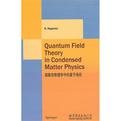凝聚态物理学中的量子场论
出版时间:2010-8 出版社:世界图书出版公司 作者:[日] 永長直人 (Naoto Nagaosa) 页数:206
Tag标签:无
前言
Why is quantum field theory of condensed matter physics necessary?Condensed matter physics deals with a wide variety of topics, ranging from gas to liquids and solids, as well as plasma, where owing to the interplay between the motions of a tremendous number of electrons and nuclei, rich varieties of physical phenomena occur. Quantum field theory is the mostappropriate "language", to describe systems with such a large number of degrees of freedom, and therefore its importance for condensed matter physics is obvious. Indeed, up to now, quantum field theory has been succesfully applied to many different topics in condensed matter physics. Recently, quantum field theory has become more and more important in research on the electronic properties of condensed systems, which is the main topic of the present volume.Up to now, the motion of electrons in solids has been successfully described by focusing on one electron and replacing the Coulomb interaction of all the other electrons by a mean field potential. This method is called mean field theory, which made important contributions to the explanantion of the electronic structure in solids, and led to the classification of insulators, semiconductors and metals in terms of the band theory. It might be said that also the present achievements in the field of semiconductor technology rely on these foundations.In the mean field approximation, effects that arise due to the correlation of the motions of many particles, cannot be described. It has been treated in a perturbative way under the assumption that its effect is small. However, recently, many systems that cannot be described in this standard wayhave been discovered, and it became clear that a new world opened its doors. Connected to these new aspects of condensed matter physics, the most fundamental problem of quantum theory - the duality between the particle picture and the wave picture - appeared in a very striking way. This particle-wave duality appears in the framework of many-particle quantum field theory as a canonical conjugate relation between the particle number and the quantum mechanical phase.
内容概要
Condensed matter physics deals with a wide variety of topics, ranging from gas to liquids and solids, as well as plasma, where owing to the interplay between the motions of a tremendous number of electrons and nuclei, rich varieties of physical phenomena occur. Quantum field theory is the most.
作者简介
作者:(日本)纳高萨(N.Nagaosa)
书籍目录
1. Review of Quantum Mechanics and Basic Principles of Field Theory1.1 Single-Particle Quantum Mechanics1.2 Many-Particle Quantum Mechanics: Second Quantization..1.3 The Variation Principle and the Noether Theorem1.4 Quantization of the Electromagnetic Field2. Quantization with Path Integral Methods2.1 Single-Particle Quantum Mechanics and Path Integrals2.2 The Path Integral for Bosons2.3 The Path Integral for Fermions2.4 The Path Integral for the Gauge Field2.5 The Path Integral for the Spin System3. Symmetry Breaking and Phase Transition3.1 Spontaneous Symmetry Breaking3.2 The Goldstone Mode3.3 Kosterlitz-Thouless Transition3.4 Lattice Gauge Theory and the Confinement Problem4. Simple Examples for the Application of Field Theory4.1 The RPA Theory of a Coulomb Gas4.2 The Bogoliubov Theory of Superfluidity5. Problems Related to Superconductivity5.1 Superconductivity and Path Integrals5.2 Macroscopic Quantum Effects and Dissipation: The Josephson Junction5.3 The Superconductor-Insulator Phase Transition in Two Dimensions and the Quantum Vortices6. Quantum Hall Liquid and the Chern-Simons Gauge Field6.1 Two-Dimensional Electron System6.2 Effective Theory of a Quantum Hall Liquid6.3 The Derivation of the Laughlin Wave FunctionAppendixA. Fourier TransformationB. Functionals and the Variation PrincipleC. Quantum Statistical MechanicsReferencesIndex
章节摘录
插图:
编辑推荐
《凝聚态物理学中的量子场论》是由世界图书出版公司出版的。
图书封面
图书标签Tags
无
评论、评分、阅读与下载
用户评论 (总计6条)
- nagaosa的这本小书只适合学过场论的人做复习的时候使用,其中的一些论述蛮简明扼要的。如果是初学,还是得看altland & simons的书。
- 作者是日本人。。。花5秒钟就能找到他的主页上写的大大的汉字名字:永長 直人——由此可以看出编辑是多么不认真。。。书对于初学者有点难了,个人比较喜欢Altland Simons那本,或者短点的Bruus那本
- nagaosa应该有中文名,世图竟然音译了
- 好书,虽然挺薄的,但是日本人写的挺好~
- 很好的教材,经常阅读!
- 很不错的书,世图牛逼,国外上百美元的书到国内只卖二十几。
